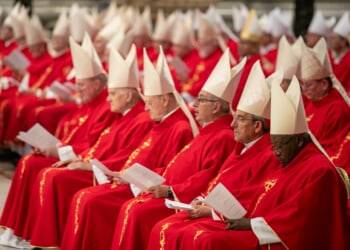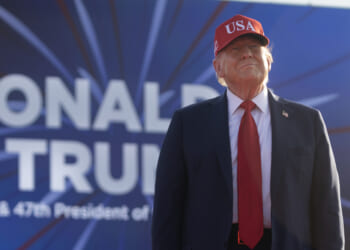Things have been pretty quiet at the box office this year. Leading it this week was the largely unremarked horror film Sinners. Coming in at number two was … Revenge of the Sith? No, your eyes do not deceive you. To mark its 20th anniversary, the final installment of George Lucas’s Star Wars prequel trilogy was rereleased, evidently to thunderous applause (sorry). With a gross haul of $42 million worldwide, it’s the biggest re-release since 2011. Why? There’s a simple answer that’s been obscured as of late: people still like Star Wars.
The problem for the current owners of the franchise, however, is that people are through with Disney Star Wars. What started with palpable and electric enthusiasm around 2015’s The Force Awakens has dissipated into the static background noise of modern life, as Disney has sought to wring every penny out of the franchise that it can.
The Force Awakens was fundamentally a cowardly film that sought to retell the original Star Wars with different characters and a glossier coat of paint, and the sequels only got worse from there. By the time they finished with The Rise of Skywalker five years later, all but the most diehard defenders of Disney’s episodic trilogy had abandoned it. Now, there are very few people who could even tell you what the latest Star Wars shows on Disney+ are without looking them up.
There was a curious side effect of Disney Star Wars, though. The Star Wars prequel trilogy had spent the former half of the 2010s as the whipping boy of innumerable video essays and message board comments. The plots, acting, and dialogue were ridiculed endlessly, with blame left solely at the feet of their creator, George Lucas. They were the canonical examples of the risk of letting one man run amok with no checks on his creative power. In fact, the cautiousness of The Force Awakens was largely explained as a desire to prove that, after the prequels, Disney could do Star Wars “right.”
But time is a fickle thing. As Disney pushed out movie after movie bearing the logo “Star Wars,” debates that were considered settled were reopened. Arguments once dismissed were reconsidered. And questions that were once considered answered were second guessed. Namely: were the prequels really that bad?
The answer from fans, increasingly, was no. Perhaps it was the rose tinted glasses, but the prequels had something that made them feel like real Star Wars in a way that the sequels simply didn’t.
Revenge of the Sith specifically has a lot to recommend it. The sprawling space opera realizes the promise of the prequel saga, that being showing Anakin Skywalker’s transformation of Darth Vader. Ian McDermont’s Palpatine/Darth Sidious (not the most subtle Sith name, it must be said) is wonderfully acted and the actor seems to really be enjoying himself in the role. Ewan McGregor’s Obi Wan Kenobi is solid, and even Hayden Christiansen’s Anakin Skywalker, despite some bad moments, has his good ones as well.
The plot, while having some flaws, is overall coherent and the score by John Williams is possibly his best. The action is great, the Anakin vs Obi Wan lightsaber duel is the strongest in any Star Wars film, and most of the CGI still holds up 20 years later.
That all being said, there’s still plenty wrong with Revenge of the Sith. Lucas still seemed to struggle with a lot of romantic dialogue. While perhaps somewhat better than in Attack of the Clones, whatever chemistry Anakin and Padme have is largely carried by John William’s score. Some of the non-romantic dialogue is hardly better — Anakin stipulating that “[f]rom my point of view, the Jedi are evil.” — while in the midst of a lightsaber duel floating on a lava river on a hellish volcanic planet rarely fails to elicit a cringe.
The most glaring problems, though, are some crucial steps on Anakin’s path into the dark lord we know from the original films. Anakin’s fall is largely earned up until after he prevents Jedi Master Mace Windu from killing Palpatine and is properly dubbed Darth Vader.
Anakin believes that he needs Palpatine’s power to save his wife Padme from death in childbirth, so he needs to keep him alive and learn his powers to a certain extent. That’s perfectly fine writing. The problem is that right after that, Anakin promptly murders many, many children at the Jedi temple. I understand the argument that Anakin essentially said to himself “well, I’ve already gone this far with being bad, so might as well go all the way,” but that’s such a drastic moral heel turn that it breaks immersion.
What must be understood, though, is that mistakes of the prequels are fundamentally human mistakes. They are mistakes made by George Lucas while in the process of trying to tell the story he wanted to tell as best he could. There’s something noble in sticking so strongly to his vision like that, even in the face of withering public criticism. The stories told by the prequels are often flawed in their execution, but the world they take place in feels alive and vibrant, which is why it’s been fodder for so many books and video games.
Revenge of the Sith is assuredly an imperfect movie, but fans don’t need or even want perfection. They just want to watch something with a soul, something they can tell was made by someone who cares. And there’s no amount of money that Disney can throw at Star Wars or any other franchise that will give them that
READ MORE from Steven Kapustka:


![Trump Posts Hilarious Pope Meme, Leftists Immediately Melt Down [WATCH]](https://www.right2024.com/wp-content/uploads/2025/05/Trump-Posts-Hilarious-Pope-Meme-Leftists-Immediately-Melt-Down-WATCH-350x250.jpg)


![Bessent Exposes Media Lies About April’s Stock Market Performance [WATCH]](https://www.right2024.com/wp-content/uploads/2025/04/Bessent-Exposes-Media-Lies-About-Aprils-Stock-Market-Performance-WATCH-350x250.jpg)


![Taylor Swift Slams Subpoena in Blake Lively’s Explosive Legal Battle [WATCH]](https://www.right2024.com/wp-content/uploads/2025/05/1746936931_Taylor-Swift-Slams-Subpoena-in-Blake-Livelys-Explosive-Legal-Battle-350x250.jpg)
![Eric Adams Pushes Back on Schumer’s Coast Guard Cutback Claims After Brooklyn Bridge Tragedy [WATCH]](https://www.right2024.com/wp-content/uploads/2025/05/Eric-Adams-Pushes-Back-on-Schumers-Coast-Guard-Cutback-Claims-350x250.jpg)
![ICE Facility Under Siege in Portland as Mob Tries to Breach Cells [WATCH]](https://www.right2024.com/wp-content/uploads/2025/07/ICE-Facility-Under-Siege-in-Portland-as-Mob-Tries-to-350x250.jpg)





